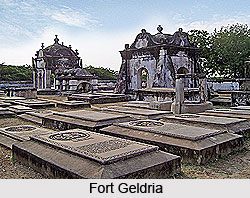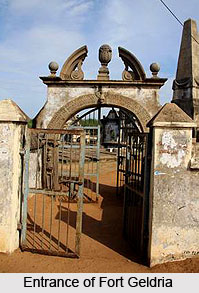 In 1714 the fort was repaired and renovated. The British occupied from 1781 to 1785. The Dutch in 1795 gave up the fort to the British. On 1st June 1825 the British government was given the final ownership of the fort. Geldria Fort remained under the British from 1825 until Indian Independence. Fort Geldria situated in Pulicat in the Indian state of Tamil Nadu was built by Dutch East India Company in the year 1613. It was built on the bank of the Pulicat Lake. The fort served as the seat for the first settlement of the Dutch Republic in India. Later in the year 1616 it became the centre of local governmental. The fort was guarded by a garrison of 80 to 90 men. At that time Fort Geldria was the only fortification in the Indian empire. The other positions held by the Dutch East India Company served as trading posts. The 400 years old fort in Pulicat, located about 60 km to the north of Chennai, is about to be excavated by the Archaeological Survey of India.
In 1714 the fort was repaired and renovated. The British occupied from 1781 to 1785. The Dutch in 1795 gave up the fort to the British. On 1st June 1825 the British government was given the final ownership of the fort. Geldria Fort remained under the British from 1825 until Indian Independence. Fort Geldria situated in Pulicat in the Indian state of Tamil Nadu was built by Dutch East India Company in the year 1613. It was built on the bank of the Pulicat Lake. The fort served as the seat for the first settlement of the Dutch Republic in India. Later in the year 1616 it became the centre of local governmental. The fort was guarded by a garrison of 80 to 90 men. At that time Fort Geldria was the only fortification in the Indian empire. The other positions held by the Dutch East India Company served as trading posts. The 400 years old fort in Pulicat, located about 60 km to the north of Chennai, is about to be excavated by the Archaeological Survey of India.
History of Fort Geldria
Fort Geldria being on the shores of Pulicat Lake helps in providing easy access to the Bay of Bengal and the Coromandel Coast. The place served as a significant place for carrying out different types of trading activities. It was a prime centre for of rivalry between the Portuguese, colonial powers of the Dutch and the British. The Fort Geldria was constructed on the foundation of a Portuguese fort that existed there much before. The permission for the construction of the fort was given by the local ruler, Queen Oboyama. He has contributes a substantial amount for the construction work and thus also became a partial owner of the monument. However, the process was building process was very slow hence the Dutch took the decision of funding and building the monument themselves.
 Fort Geldria was later attacked by a local chieftain, Etheraja after a lapse of one month. Later the Portuguese attacked the fort from land and sea. However, they were fought off. The Dutch then made a pact with the local traders to keep the Portuguese away from the fort. The building is said to have provided refuge to many from the Portuguese colonies. The chief at the Fort was bestowed with the title Governor and Extraordinary Councillor of the Indies in the year 1619. Slowly during the second half of the seventeenth century, the importance of the fort as a centre for trading began to decline because of the tough competition from the British as well as from the Mughal Dynasty. In the year 1689, the government shifted to Negapatnam and then to Ceylon.
Fort Geldria was later attacked by a local chieftain, Etheraja after a lapse of one month. Later the Portuguese attacked the fort from land and sea. However, they were fought off. The Dutch then made a pact with the local traders to keep the Portuguese away from the fort. The building is said to have provided refuge to many from the Portuguese colonies. The chief at the Fort was bestowed with the title Governor and Extraordinary Councillor of the Indies in the year 1619. Slowly during the second half of the seventeenth century, the importance of the fort as a centre for trading began to decline because of the tough competition from the British as well as from the Mughal Dynasty. In the year 1689, the government shifted to Negapatnam and then to Ceylon.
In 1714 the fort was repaired and renovated. The British occupied from 1781 to 1785. After some time the trading activities in the fort began again. Ships from different places like Golkonda and Suratte arrived at the fort with loaded merchandise every month. The Dutch in 1795 gave up the fort to the British. On 1 June 1825 the British government was given the final ownership of the fort. Geldria Fort remained under the British from 1825 until Indian independence. Presently it is under the Archaeological Survey of India.
Architecture of Fort Geldria
The Fort Geldria entrance is located on the southern side facing the main Dutch street. The different levels of the fort include the lowest level which has moat on all sides. Between the moat and the main fort wall was a level which was at the height of the inner ground level of the fort. There was a higher level between the wall and the inner level of the fort. This level was uniform on all sides and in the Bastions for facilitating the easy movement of the Cannons.
This very elegant fort is having seven Bastions and it is in rectangular plan. The Bastions are located at the edges of the square plan and they project out in a triangular form. The bastions can be accessed by the ramp near the North West bastion. Each Bastion has battlements and seven or eight provision for mounting the cannon in firing position.
Nearby Attractions at Fort Geldria
Within the fort, wells were dug to ensure water supply for the inhabitants. One of the maps shows three wells within the fort walls. Cemetery inside the fort has many graves. Most of the graves belong to the Dutch and most of them have detailed carving on the tomb stones.



















